An Analysis of Environment Behavior Relationships towards the Design of a Local Mixed-used Street: Based on Behavior Settings of Belgium Street in Cebu City, Philippines
Abstract
:1. Introduction
1.1. Background
1.2. Research Status
1.3. Purpose and Significance of Research
2. Materials and Methods
2.1. Research Area
2.2. Data Collection
2.3. Classification of Behavior Settings
2.4. Spatial and Time Analyses
2.5. Interview Analysis
3. Results
3.1. Behavior Settings
3.2. Spatial Analysis
3.2.1. Location of Behavior Settings along Belgium Street
3.2.2. Causes of the Occurrence of Behavior Settings along Belgium Street based on Street Use
3.3. Time Analysis
3.3.1. Weekday and Weekend Comparison
3.3.2. Movement of Behavior Settings along Belgium Street
3.4. Summary of Results from the Spatial and Time Analyses
- Permanent Zone—This zone consists of permanent structures such as the built residents that are bounded by their property lines.
- Semi-Permanent Zone—This zone consists of the sidewalks which accommodate activities and elements such as vending stalls, furniture and retractable canopies bounded by the edge of the curb.
- Temporary Zone—This zone occupies part of the carriageway, and is flexible in nature, as it can accommodate activities and elements such as the lightweight furniture and parked vehicles that are easy to move away from vehicular traffic or during demolitions by the government. In addition, it substitutes as sidewalks for pedestrians to walk on at different times.
- Transit Zone—This zone consists of the circulation area mainly for pedestrian and vehicular traffic.
3.5. Interviews with Respondents
3.5.1. Conceptualization of Design Proposals as an Interview Tool
3.5.2. Results of Interviews
4. Discussion
5. Conclusions
- (1)
- Four classifications of behavior settings and their types that helped describe Filipino behavior were discovered on the street. These behavior settings give an understanding as to how the street serves its purpose of providing people a means of socialization (IG), relaxation (PSD), an opportunity to make profit (PD), and gather around activities of interest (PT). In addition, the use of classifying behavior settings can help quantify existing behaviors on streets for analysis.
- (2)
- Utilizing streets as a space which accommodates temporary uses that preserve people’s behaviors further strengthening its role as a public space, filling the need for providing open space while being able to accommodate vehicular traffic.
- (3)
- The discovery of a series of zones on the use of the street that accommodate permanent structures (permanent zone); activities, vending stalls and furniture (semi-permanent zone); activities, walking, lightweight furniture, parking space (temporary zone); and circulation for vehicles and pedestrians (transit zone) can be applied in the improvement of other streets with similar characteristics.
Supplementary Materials
Author Contributions
Acknowledgments
Conflicts of Interest
References
- Park, S. A preliminary study on connectivity and perceived values of community green spaces. Sustainability 2017, 9, 692. [Google Scholar] [CrossRef]
- Kim, S.; Kwon, H. Urban sustainability through public architecture. Sustainability 2018, 10, 1249. [Google Scholar] [CrossRef]
- Jacobs, J. The Death and Life of Great American Cities; Random House: New York, NY, USA, 1961. [Google Scholar]
- Lynch, K. The Image of the City; MIT Press: New York, NY, USA, 1960. [Google Scholar]
- Hassen, N.; Kaufman, P. Examining the role of urban street design in enhancing community engagement: A literature review. Health Place 2016, 41, 119–132. [Google Scholar] [CrossRef] [PubMed]
- Gehl, J. Life between Buildings—Using Public Space; Van Nostrand Reinhold: New York, NY, USA, 1987. [Google Scholar]
- Carmona, M.; Heath, T.; Oc, T.; Tiesdell, S. Public Places–Urban Spaces; Architectural Press: Abingdon, UK, 2003. [Google Scholar]
- Metha, V. Determining environmental characteristics to support social behavior. J. Plan. Educ. 2007, 27, 165–187. [Google Scholar]
- Carmona, M. London’s local high streets: The problems, potential and complexities of mixed street corridors. Prog. Plan. 2015, 100, 1–84. [Google Scholar] [CrossRef]
- Barton, H. Land use planning and health and well-being. Land Use Policy 2009, 26S, S115–S123. [Google Scholar] [CrossRef]
- Oranratmanee, R.; Sachakul, V. Streets as public spaces in southeast Asia: Case of Thai pedestrian streets. J. Urban Des. 2014, 19, 211–229. [Google Scholar] [CrossRef]
- Appleyard, D. Streets can kill cities: Third world beware—Guidelines for street design in third world cities. Habitat Int. 1983, 7, 111–122. [Google Scholar] [CrossRef]
- Dela Paz, F.I. Savouring the streets of Sampaloc: Rediscovering its local flavour. In On Asian Streets and Public Space; Heng, C.K., Low, B.L., Hee, L., Eds.; NUS Press Pte Ltd.: Singapore, 2009; pp. 93–104. [Google Scholar]
- Drummond, L. Street scenes: Practices of public and private space in urban Vietnam. Urban Stud. 2000, 37, 2377–2391. [Google Scholar] [CrossRef]
- Mojares, R. Dakbayan: A cultural history of space in a Visayan City. Philipp. Q. Cult. Soc. 1999, 27, 117–132. [Google Scholar]
- Connel, J. Beyond Manila: Walls, malls and private spaces. Environ. Plan. A 1999, 31, 417–439. [Google Scholar] [CrossRef]
- Brown, G.; Rhodes, J.; Dade, M. An evaluation of participatory mapping methods to assess urban park benefits. Landsc. Urban Plan. 2018, 178, 18–31. [Google Scholar] [CrossRef]
- Garcia-Ayllon, S. Rapid development as a factor of imbalance in urban growth of cities in Latin America: A perspective based on territorial indicators. Habitat Int. 2016, 58, 127–142. [Google Scholar] [CrossRef]
- Gonzales, Y.V. PH Cities Lack ‘Visual Harmony,’ Walkable Streets, Says Expert. Available online: http://newsinfo.inquirer.net/737498/ph-cities-lack-visual-harmony-walkable-streets-says-expert (accessed on 20 July 2017).
- Philstar Global. Too Many Malls, Not Enough Parks. Available online: https://www.philstar.com/business/2016/12/05/1650279/too-many-malls-not-enough-parks (accessed on 20 July 2017).
- Business Mirror. Time to Think, Talk about Green Space. Available online: https://businessmirror.com.ph/time-to-think-talk-about-green-space/ (accessed on 20 July 2017).
- Cebu Daily News. Green Spaces and Metro Cebu. Available online: http://cebudailynews.inquirer.net/148905/green-spaces-metro-cebu (accessed on 5 October 2017).
- The Manila Times. Parks and Open Spaces. Available online: http://www.manilatimes.net/parks-and-open-spaces/171938/ (accessed on 20 July 2017).
- Iloilo Metropolitan Times. Walk Along the Esplanade and Experience Outdoor Environment. Available online: http://www.iloilometropolitantimes.com/walk-along-the-esplanade-and-experience-outdoor-environment/ (accessed on 16 July 2018).
- JICA. The Roadmap Study for Sustainable Urban Development in Metro Cebu. Available online: https://www.jica.go.jp/philippine/english/office/topics/news/c8h0vm00009pqw0q-att/151102_01.pdf (accessed on 18 April 2016).
- Rappler. Road Sharing to Take Place in 4 Cebu City Roads. Available online: https://www.rappler.com/science-nature/society-culture/70292-road-sharing-cebu-city-roads (accessed on 18 April 2016).
- Sunstar Philippines. No More Drinking in Public Places Soon. Available online: https://www.sunstar.com.ph/article/422282/No-more-drinking-in-public-spaces-soon (accessed on 16 July 2018).
- Philstar Global. Anti-tambay Crackdown Nets 7291 in Metro Manila. Available online: https://www.philstar.com/headlines/2018/06/21/1826575/anti-tambay-crackdown-nets-7291-metro-manila (accessed on 16 July 2018).
- CNN Philippines. Senator Bam Aquino, House Lawmakers, Seek Probe of Anti-tambay Policy. Available online: http://cnnphilippines.com/news/2018/06/25/Duterte-PNP-tambay-arrest-Senate-House-investigation-Bam-Aquino.html (accessed on 16 July 2018).
- Siu, K. Guerilla wars in everyday public spaces: Reflections and inspirations for designers. Int. J. Des. 2007, 1, 37–56. [Google Scholar]
- Panek, J.; Benediktsson, K. Emotional mapping and its participatory potential: Opinions about cycling conditions in Reykjavik, Iceland. Cities 2017, 61, 65–73. [Google Scholar] [CrossRef]
- Serra-Coch, G.; Chastel, C.; Campos, S.; Coch, H. Graphical approach to assess urban quality: Mapping walkability based on the TOD-standard. Cities 2018, 76, 58–71. [Google Scholar] [CrossRef]
- Project for Public Spaces. How to Turn a Place Around: A Handbook for Creating Successful Public Spaces; Project for Public Spaces: New York, NY, USA, 2000. [Google Scholar]
- Barker, R. Ecological Psychology: Concepts and Methods for Studying the Environment and Human Behavior; Stanford University Press: Stanford, CA, USA, 1968. [Google Scholar]
- Schoggen, P. Behavior Settings: A Revision and Extension of Roger G. Barker’s Ecological Psychology; Stanford University Press: Stanford, CA, USA, 1989. [Google Scholar]
- World Resources Institute. Cities safer by design: Guide and Examples to Promote Traffic Safety through Urban and Street Design. Available online: https://www.wri.org/sites/default/files/CitiesSaferByDesign_final.pdf (accessed on 10 May 2018).
- Faria, P.; Ferreira, F.; Jalali, M.; Bento, P.; Antonio, N. Combining cognitive mapping and MCDA for improving quality of life in urban areas. Cities 2018, 78, 116–127. [Google Scholar] [CrossRef]

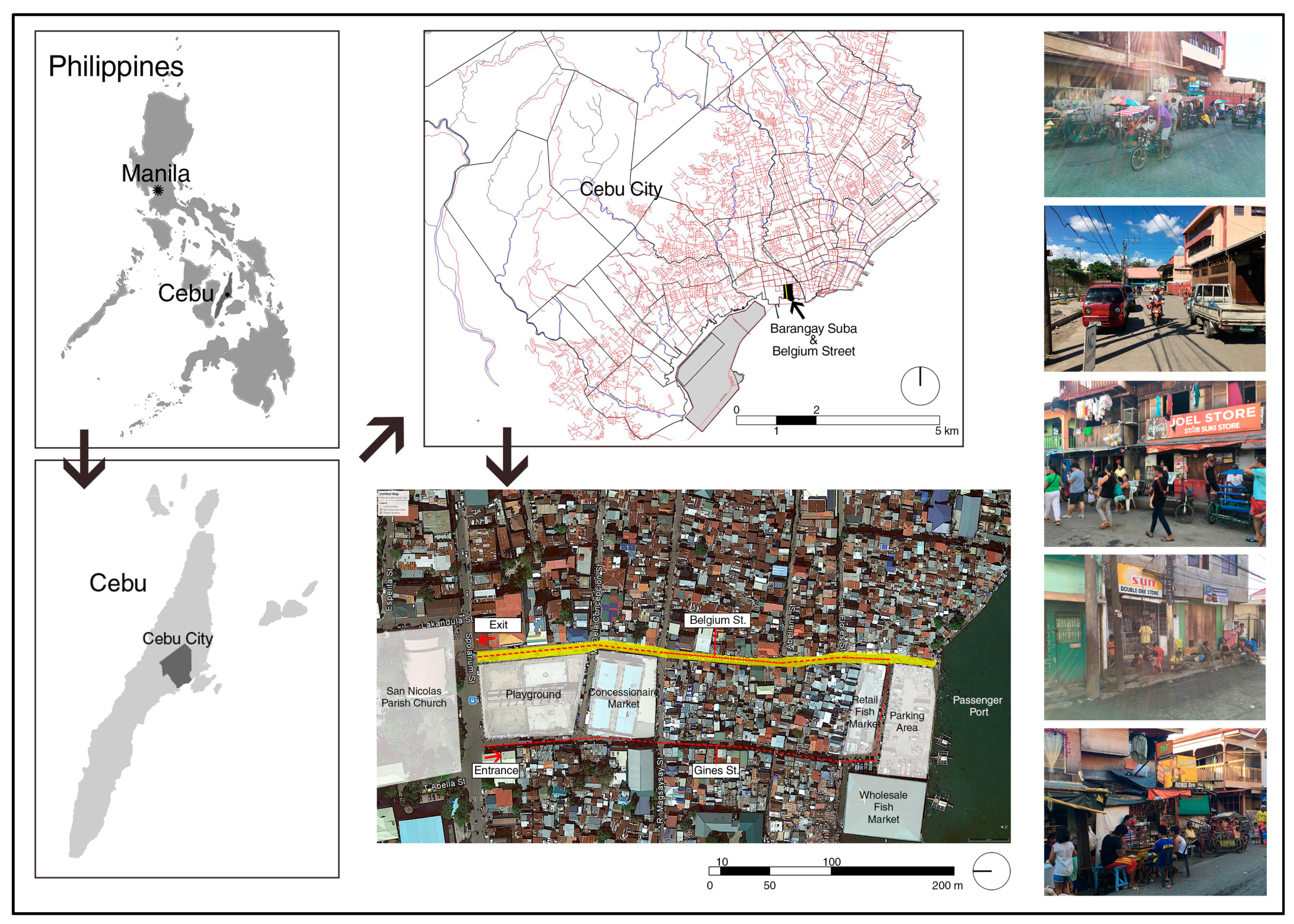





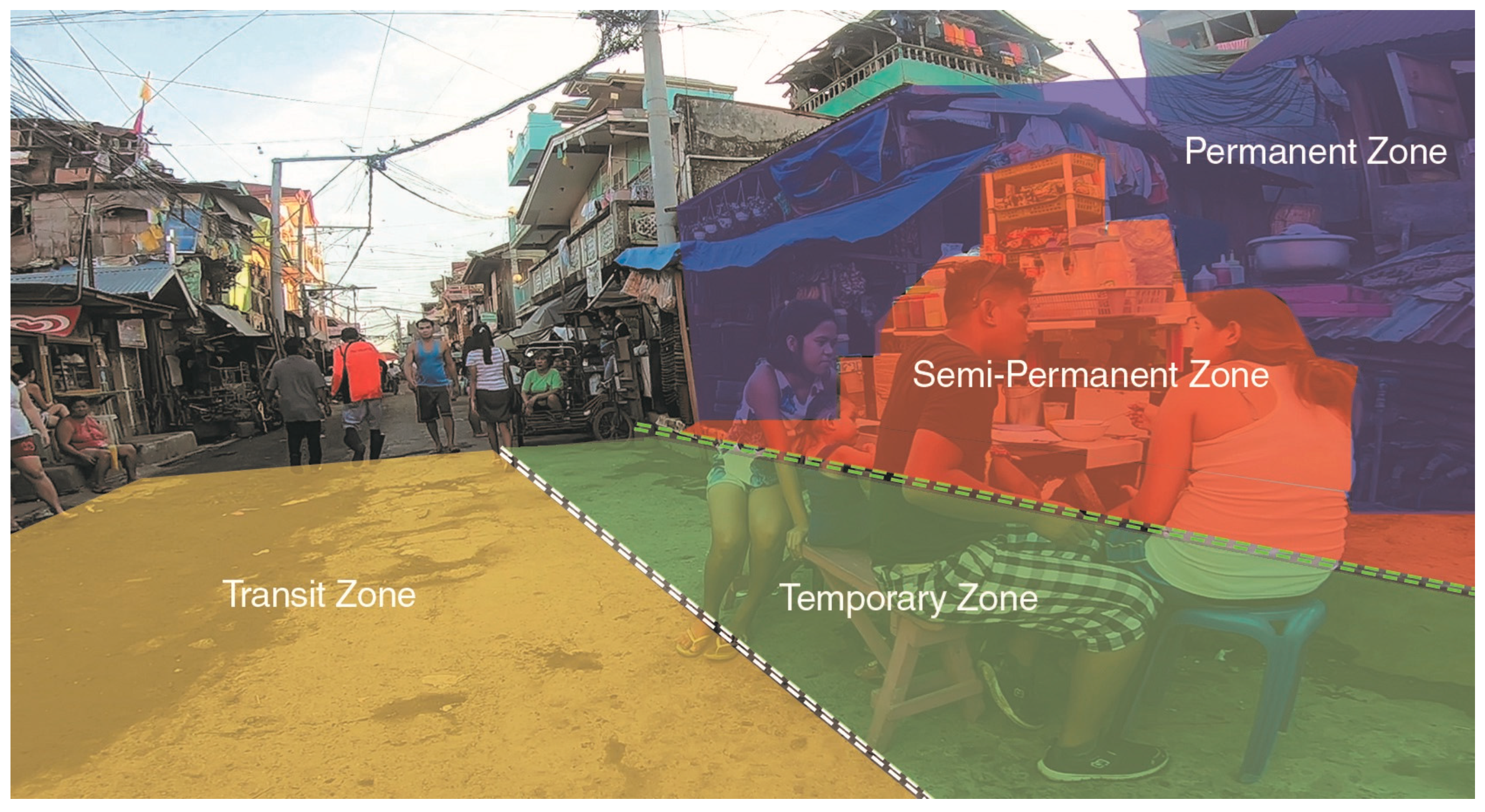
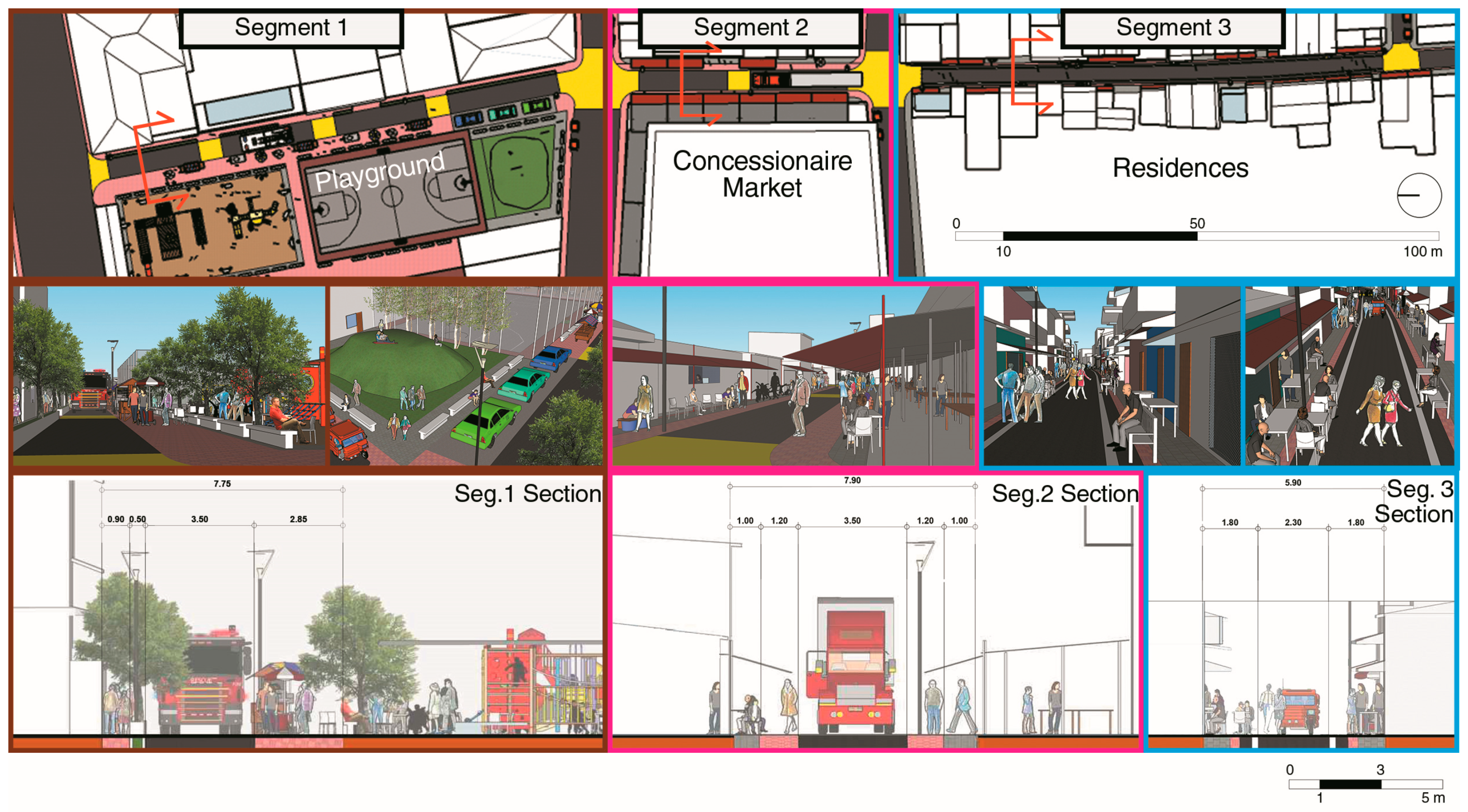
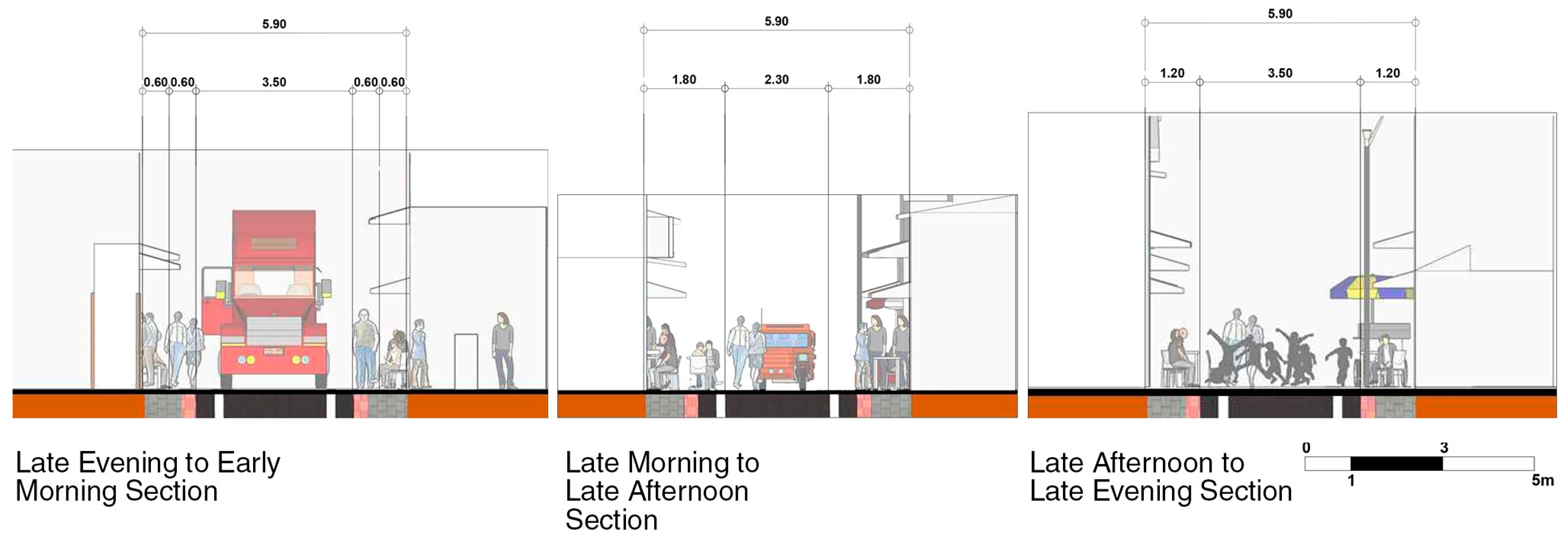

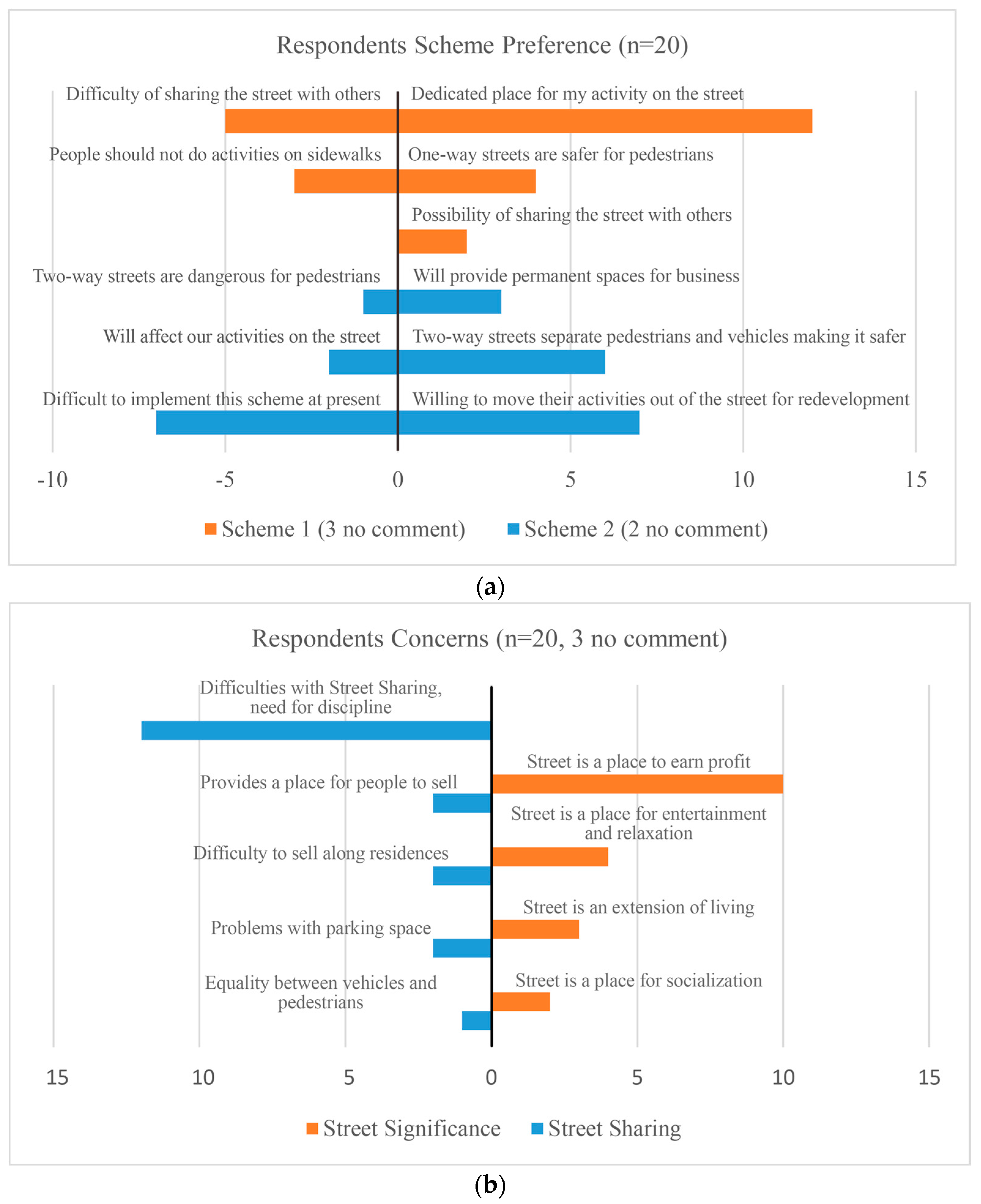
| Area Name | Barangay Suba | |||
|---|---|---|---|---|
| Location | Cebu City South District | |||
| Population | 11,026 (as of 2015) | |||
| Percentage of Elderly | 0.05% | |||
| Household | 1766 (as of 2000) | |||
| Persons per Household | 4.69 (as of 2000) | |||
| Street Name | Belgium Street | |||
| Classification | City Road | |||
| Length | 350 m | |||
| Width | Varies (from 6 m to 10 m) | |||
| Material | Reinforced Concrete and Asphalt | |||
| Structures and Amenities along Belgium Street | Residences, Commercial Buildings, Playground, Concessionaire and Retail Fish Markets, Passenger Port | |||
| Construction Material | Reinforced Concrete, Light Materials | |||
| Height of Structures | 1–6 stories | |||
| Proposed Expansion of Belgium Street | Proposed Widening: 12 m | Plant Strips: 0.60 m | Sidewalk (One Side): 2 m | Sidewalk Classification: Arcaded |
| Istambay sa Gawas (IG) To socialize with others on the street | ||
 IG-1: In a Private Meeting |  IG-2: Around the Family Circle | |
| Pahangin sa Dalan (PSD) To use the street as a place to relax | ||
 PSD-1: Alfresco Dining |  PSD-2: Idling Around |  PSD-3: Blending with the Streetscape |
| Patagad (PD) To seek attention from others to earn a profit | ||
 |  | |
| Pagtapok (PT) To crowd around an activity of interest | ||
 PT-1: Little Adventures |  PT-2: Being one with the Crowd | |
| Weekdays | Behavior Settings | Weekends | ||||||||||
|---|---|---|---|---|---|---|---|---|---|---|---|---|
| 4:00–5:00 | 8:00–9:00 | 13:00–14:00 | 16:00–17:00 | 20:00–21:00 | Total/Type | Total/Type | 4:00–5:00 | 8:00–9:00 | 13:00–14:00 | 16:00–17:00 | 20:00–21:00 | |
| PSD | ||||||||||||
| 12 | 12 | 0 | 4 | 4 | 32 | PSD-1 | 22 | 10 | 2 | 4 | 6 | 0 |
| 24 | 35 | 38 | 54 | 30 | 181 | PSD-2 | 191 | 18 | 30 | 23 | 77 | 43 |
| 10 | 1 | 2 | 4 | 0 | 17 | PSD-3 | 7 | 0 | 3 | 2 | 1 | 1 |
| IG | ||||||||||||
| 3 | 5 | 0 | 5 | 5 | 18 | IG-1 | 19 | 2 | 0 | 3 | 8 | 6 |
| 0 | 19 | 18 | 25 | 7 | 69 | IG-2 | 82 | 0 | 21 | 18 | 26 | 17 |
| PT | ||||||||||||
| 0 | 0 | 13 | 25 | 4 | 42 | PT-1 | 63 | 0 | 27 | 5 | 28 | 3 |
| 0 | 5 | 0 | 18 | 9 | 32 | PT-2 | 29 | 0 | 1 | 9 | 19 | 0 |
| PD | ||||||||||||
| 16 | 24 | 20 | 27 | 13 | 100 | - | 100 | 10 | 25 | 17 | 34 | 14 |
| 65 | 101 | 91 | 162 | 72 | 491 | Total/Day | 513 | 40 | 109 | 81 | 199 | 84 |
| Total Number of Respondents = 22 | |||||||||||
| Gender | |||||||||||
| Male | 10 persons | Female | 12 persons | ||||||||
| Age | |||||||||||
| Below 20 years | 1 person | 21–64 years | 20 persons | Above 65 years | 1 person | ||||||
| Location of Residences | |||||||||||
| In front of the Street | 7 persons | Inside the residential blocks. | 13 persons | Not from Barangay. Suba | 2 persons | ||||||
| Types of Respondents | |||||||||||
| Mobile Vendors | 2 persons | Vendors | 3 persons | Tricycle Drivers | 1 person | ||||||
| Residents | 9 persons | Customers | 2 persons | Bystanders | 5 persons | ||||||
| Scheme Preference | |||||||||||
| Scheme 1 | 9 persons | Scheme 2 | 6 persons | Undecided | 5 persons | ||||||
| Concern | Respondent, Age, Gender | Comment |
|---|---|---|
| Explanation on the current situation of their activity and purpose | Vendor, Female, 40 years old | Prefers a permanent place to sell (i.e., in the market) instead of looking for a place to sell on the street daily. |
| Bystander, Male, 70 years old | Reason for staying outside the street is because of poor housing conditions. | |
| Explanation on their views of Street Safety | Bystander, Male, 17 years old | Prefers the first scheme because it is more organized and suggests better enforcement and installing signs to properly identify the street as having a one-way traffic scheme. |
| Customer, Female, 38 years old | Prefers children not to play on the street because vehicular accidents involving children have happened before. | |
| Customer, Female, 40 years old | Sidewalks are not used for pedestrians but for storing items. Vehicles such as tricycles occupy the street making it more cramped and difficult for fire engines to pass through which caused an accident. | |
| Explanation on their views of Street Sharing | Vendor, Female, 29 years old | Prefers locating herself on the road where customers can find her. Dislikes the idea of street sharing, and is more focused on earning a profit. |
| Resident, Female, 42 years old | People are focused on their own personal matters, prioritizing themselves over others. Prefers removing activities from the street because conflicts happen between residents and people who occupy the street. | |
| Resident, Female, 41 years old * | Shares the street with her neighbor across by occupying the front of his house when it is hot and vice-versa. Does not occupy front of her house because she understands the street is a public domain shared by everyone. | |
| Resident, Female, 43 years old * | Shares the front of her house with street vendors, who in return, clean up after use and sometimes watch over house when she is away. |
© 2018 by the authors. Licensee MDPI, Basel, Switzerland. This article is an open access article distributed under the terms and conditions of the Creative Commons Attribution (CC BY) license (http://creativecommons.org/licenses/by/4.0/).
Share and Cite
Espina, J.M.; Mori, S.; Nomura, R. An Analysis of Environment Behavior Relationships towards the Design of a Local Mixed-used Street: Based on Behavior Settings of Belgium Street in Cebu City, Philippines. Sustainability 2018, 10, 3230. https://doi.org/10.3390/su10093230
Espina JM, Mori S, Nomura R. An Analysis of Environment Behavior Relationships towards the Design of a Local Mixed-used Street: Based on Behavior Settings of Belgium Street in Cebu City, Philippines. Sustainability. 2018; 10(9):3230. https://doi.org/10.3390/su10093230
Chicago/Turabian StyleEspina, Joachim Michael, Suguru Mori, and Rie Nomura. 2018. "An Analysis of Environment Behavior Relationships towards the Design of a Local Mixed-used Street: Based on Behavior Settings of Belgium Street in Cebu City, Philippines" Sustainability 10, no. 9: 3230. https://doi.org/10.3390/su10093230




